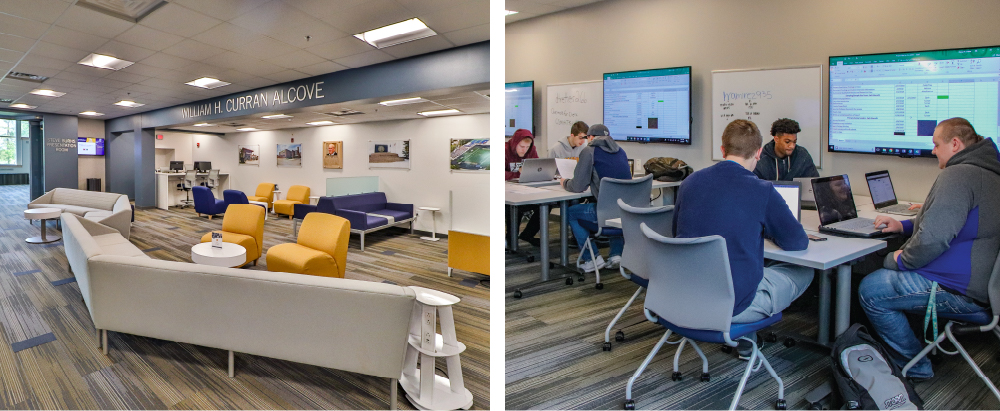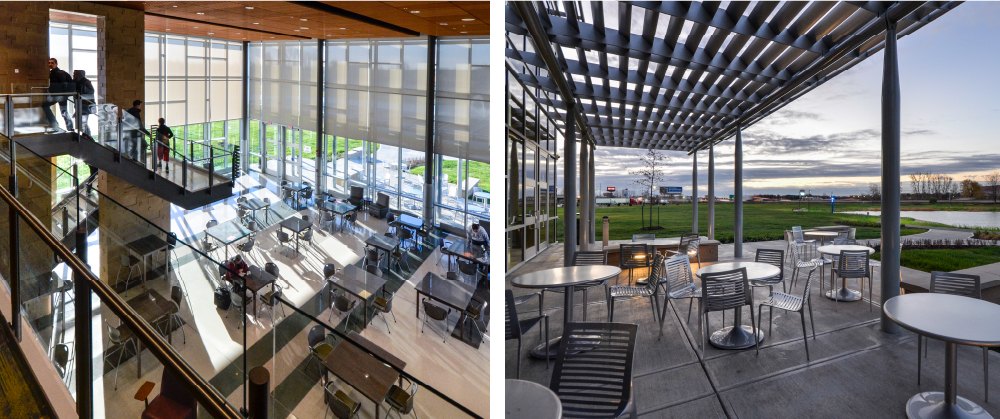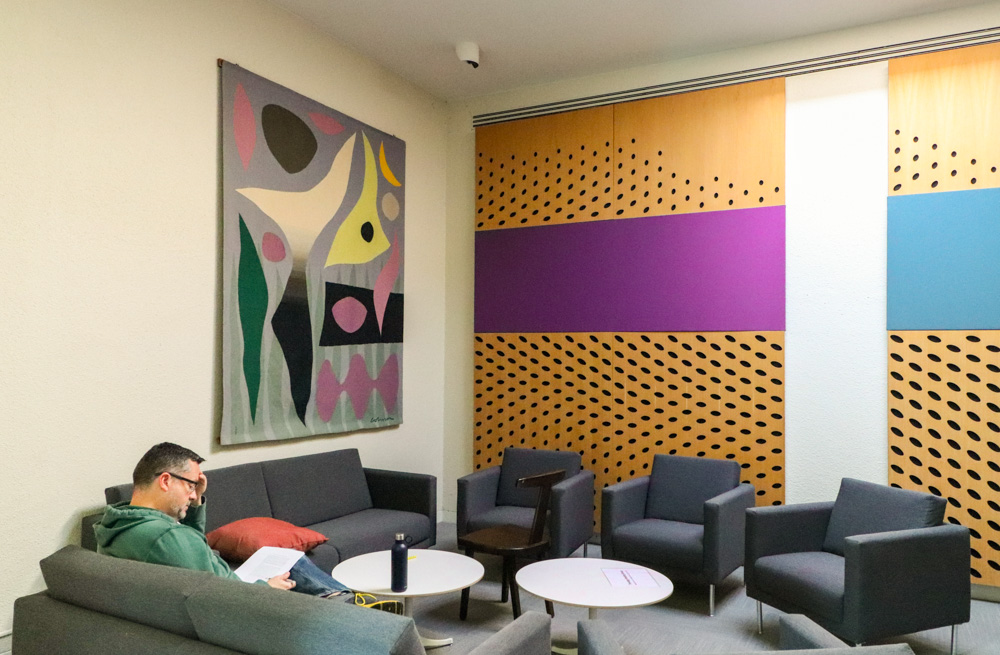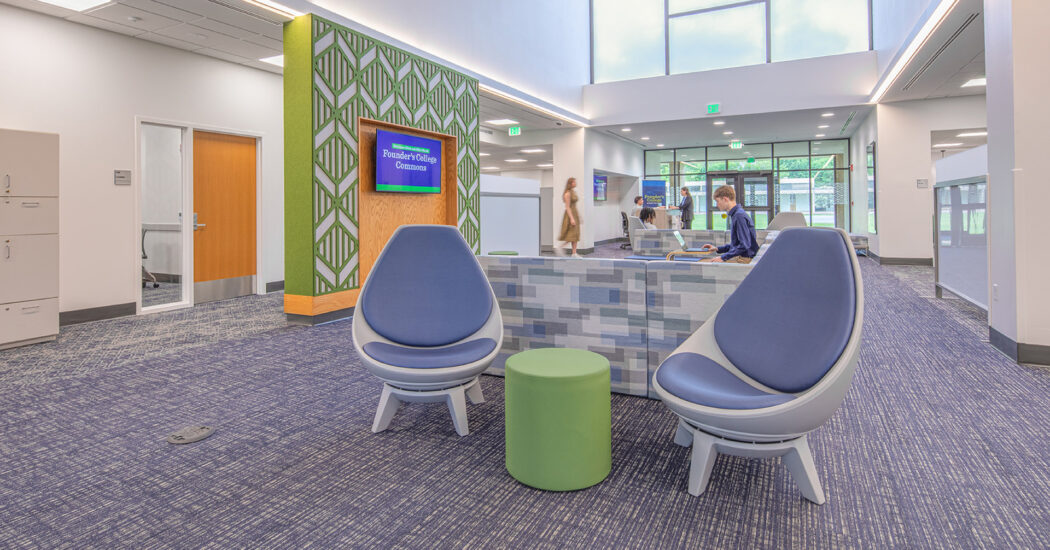Designing College Campuses for Student Health, Equity, and Performance – Part 2
-
Category
Studio-Higher Ed, Innovation -
Posted By
Sara Richey -
Posted On
Sep 28, 2021
Environmental design has an impact on occupant health, productivity, and sense of belonging. There’s no exception for students on college campuses. According to an October 2020 “Inside Higher Ed,” survey, 44 percent of student respondents said stress, anxiety, and loneliness had been their biggest challenge. In our last blog, we cited that in 2021, college presidents’ top concerns are student and faculty mental health.
Architects know that the built environment shapes occupants’ emotions, thoughts, and behaviors. So how can campuses leverage their facilities to better support students?
In part 1 of this series, we researched ‘place attachment’ and well-being ties. We discussed design techniques like daylighting, views to nature, and spatial arrangements.
This post explores three environmental design themes: Freedom + Control, Nature, and Art to understand the ‘why’ behind what.
Freedom + Control
The saying everyone learns differently is true, especially knowing no two people use identical methods to enhance their learning. As designers, our role is to provide flexible options for students to learn, collaborate, and focus.
Equally, active learning is a crucial concept that guides students through the learning process and gives them opportunities to be engaged in the classroom. According to the Yale Poorvu Center for Teaching and Learning, active learning is also commonly associated with inclusive teaching. It’s empirically shown to decrease the achievement gap for underrepresented minorities and first-generation college students, particularly in STEM fields.

Marian University School of Business
As we consider this, how we design space plays a substantial role in gaining more positive outcomes for student success. For example, in classrooms or in-between spaces, mobile tables allow students to come together in groups to share ideas and content. Lounge seating configurations provide a relaxed setting to inspire group discussion while technology integration‑at low or high-top tables or on walls in informal group settings‑allow for visuals, messaging, and enhanced communication. Also, vertical whiteboards or glass can cultivate ideas for students to solve problems together.
Additionally, learning as a class or breaking into smaller groups gives students the freedom to relate to presented content by controlling their environment and how they want and need to learn. Having flexibility with classroom technology, natural and artificial light, and content sharing gives students and faculty a feeling of purpose and belonging, which leads to engagement and choice. The culmination is enhanced learning and equity.
Nature and Learning
The Environmental Protection Agency estimates that humans spend more than 90% of their time indoors. It’s no surprise that more administrators and facilities managers are discussing the need to access nature, an important element for learning environments. Research shows that access to nature positively impacts academic learning, personal development, and environmental stewardship.
We can learn from studies ranging from healthcare settings to classrooms. A widely known study from Roger Ulrich entitled “View Through a Window May Influence Recovery from Surgery” (1984), revealed that patients in a hospital room with windows and access to nature recovered in fewer days (7.9 vs. 8.7 days), took less pain medication, and had fewer occasional nursing calls.

Ivy Tech – Anderson
In the Green Street Academy Study (2019), a middle school in Baltimore, Maryland, incorporated biophilic elements into classrooms, such as windows with views of nature, shades providing diffused daylight, and nature-inspired interior materials. Dr. Tom Albright, a neuroscientist from the Salk Institute and textile designer Sara Baderi from Designtex, collaborated to create nature-inspired wall graphics tying back to a brain-based theory. The outcome was astonishing. Students in the classroom with biophilic elements verses those without had a higher heart rate variability (HRV), equating to lower stress levels. Test scores also were 3.3 times higher than those in the classroom without biophilic elements.
Research on biophilic design is ongoing, but studies continue to show the benefits of nature, and how it impacts learning. Additionally, using colors from nature and natural elements, like living green walls are trending features intended to enhance student health. Natural finishes, specific colors and hues, and texture-rich aesthetic materials are additional cues used by designers to have positive impacts on stress reduction and mindset. Also trending on college campuses are outdoor green spaces that offer a reduction in street noise, serene settings for minds to reset, and spaces for increased collaboration, socialization, and learning.
Art integration
Many people respect and enjoy having art around, whether realized or not. Having an outlet and a way to express artistic flair can positively affect one’s mental health and well-being. Universities can achieve this by displaying art across a college campus to create a sense of community for students, and faculty alike.

Christian Theological Seminary
Art can be used in many different media, from environmental wall graphics painted, printed, or sculpted to three-dimensional art made from stone, metal, or glass. Whatever the medium, art creates positive emotion and minimizes stress.
Art’s beauty is indeed subjective, meaning everyone feels something different from one person to the next. Keeping this in mind means differences can be recognized and genuine appreciation for how we relate and move through life together can happen with understanding, solid emotions, and thoughtfulness from within. According to neuroscientist Oshin Vartanian, this happens because “areas of the brain involved in processing emotion and those that activate pleasure and reward systems” are engaged when art is perceived.
Designing with knowledge and evidence with all people in mind—equals better results for health, productivity, and equity.
*Laura Hardin, IIDA, RID contributed to this post.







